It’s a bit artificial to create a listing like this which is defined by the months of the year; as we all know, nature does not follow the human calendar. Day lengths are set and reliable, but local weather is not, and neither are the conditions within micro habitats. The natural world responds to these influences – and more – in the unfolding of various life cycles.
So I’m attempting to create a general guide by which a habitat gardener can determine to have resources available for birds in their garden at all times of the year. The first, and most important thing to remember when planting ‘for the birds’, is to include a lot of plants that attract and sustain insect populations. So, with the plants mentioned, if appropriate, I will specify an insect/plant association as well as fruits, seeds, or other materials that benefit the birds.
These monthly lists do not include large trees, mostly because a mature specimen is often already present in many gardens, and hopefully it is a native species! If so, it pays to preserve and protect an established, healthy tree, even if it’s not a native species, because most trees provide cover and nesting sites, and often some form of food as well. It is also important to avoid any major pruning work on trees and large shrubs during the nesting season. Try to schedule this kind of work between September to January or February.
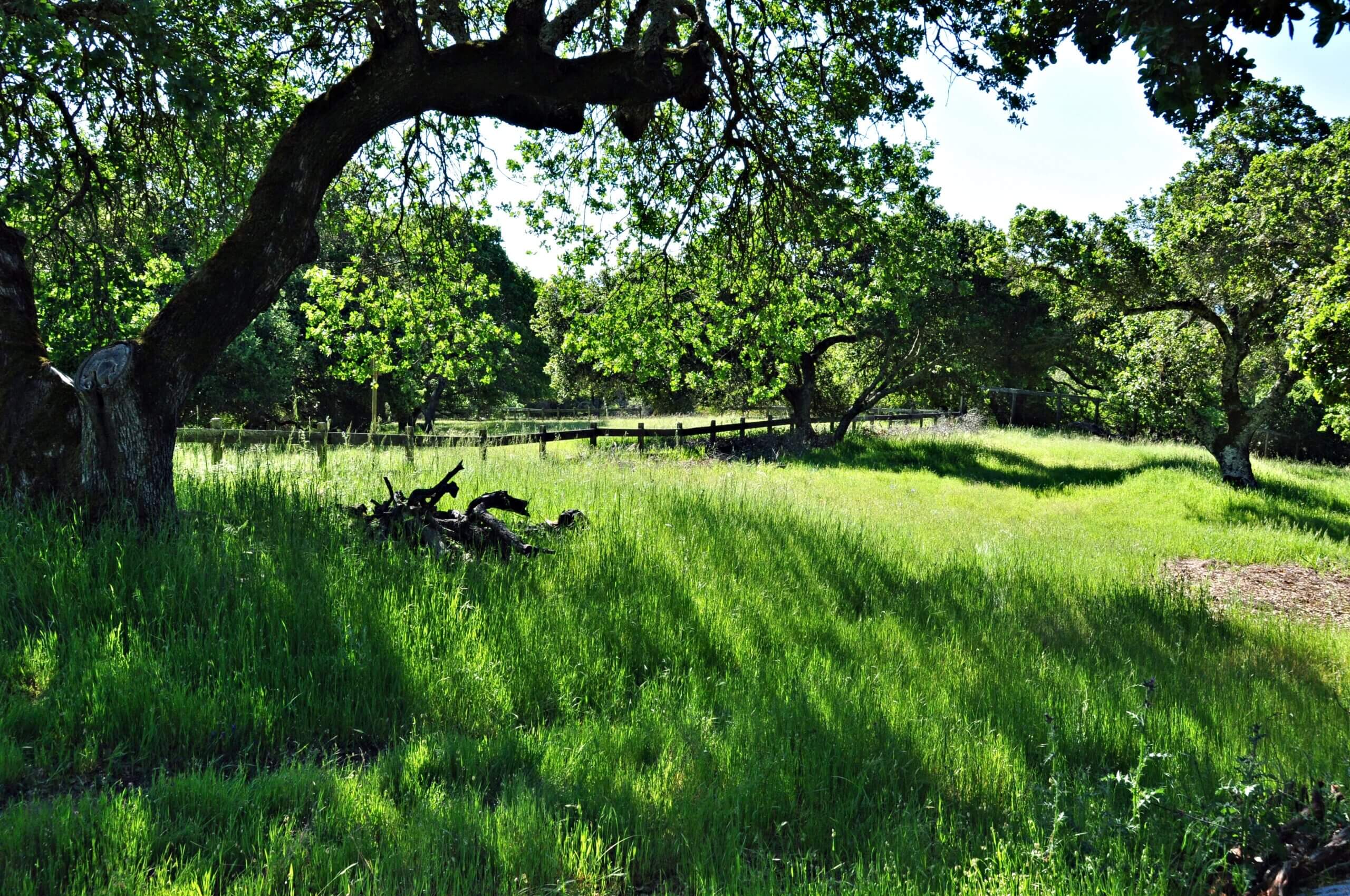
Oaks and spring grasslands
My focus for the last fourteen years has been on the plants and creatures of a California Oak Woodland, because this is the plant community I live and garden in. I have been observing and interacting with native plants and creatures while developing the resources for even richer biodiversity on our property. These are the plants and animals I know best, so this is what I write about.
You can do the same! Get to know the plant community that surrounds your home (or at least used to), and then observe the plant and animal life closely and carefully over a period of time. The “cast of characters” is often fairly stable within various types of habitat. If you live within a riparian zone, you are especially lucky, because everybody comes for the water at some point!
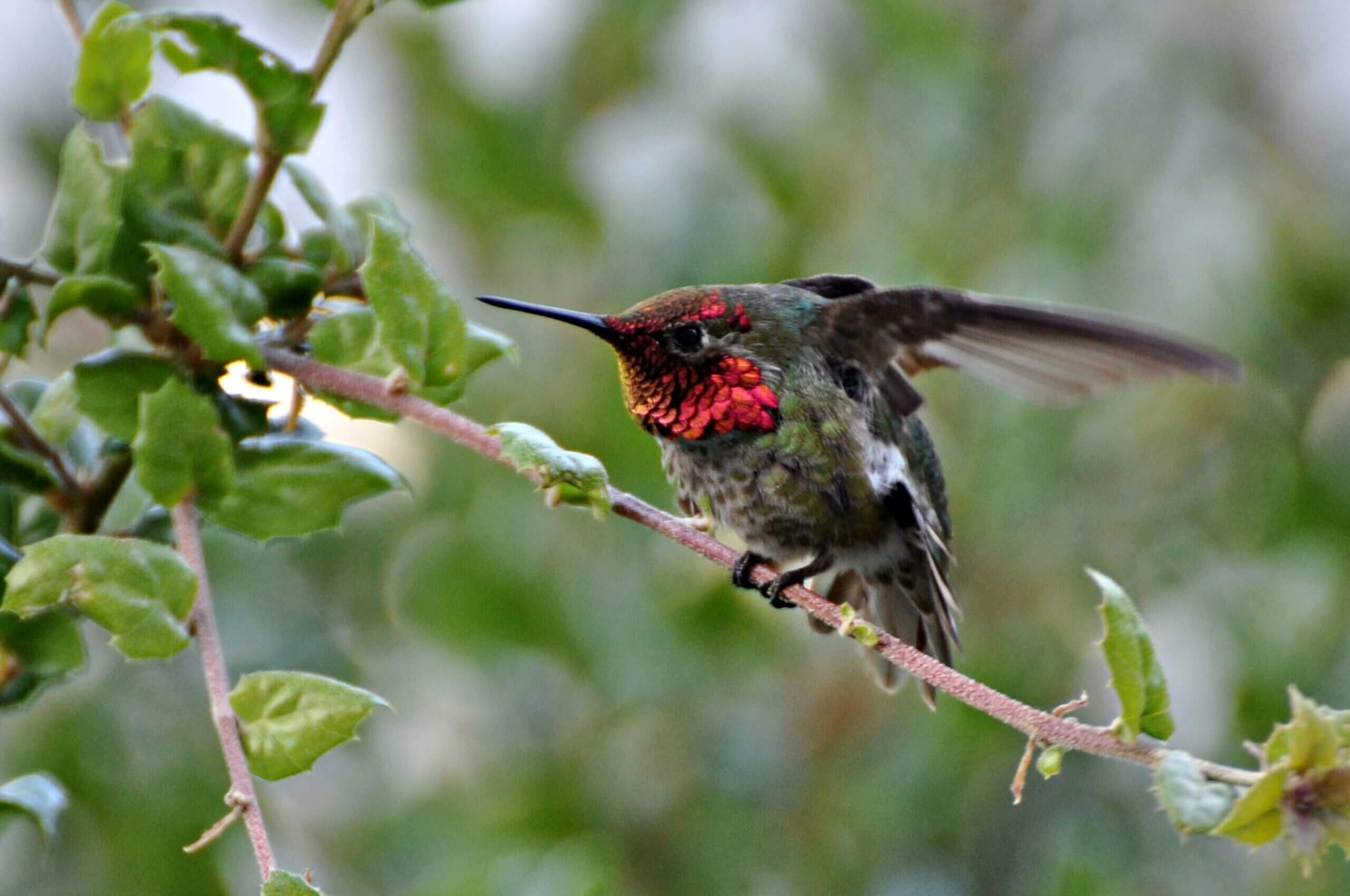
Anna’s hummingbird stretching its wings
January
Mananzitas are usually in full bloom, though some specimens may have started blooming in December. Orchard mason bees are busy pollinating the flowers, and Anna’s hummingbirds are also pollinating while foraging for nectar and small insects within the flowers. Manzanitas “little apples” ripen by summer; lots of birds and many other animals, including deer, coyotes, foxes, raccoons, and squirrels eat these fruits.
Anna’s hummingbirds sometimes breed very early in the year, so they may also be foraging for nesting materials. They pick up soft materials like the chaff that lingers after aster flowers are spent; they are also finding soft grasses and spider silk to create their tiny, but expandable, open cup nests. Bits of lichens are often “glued” to the outside of the nest for camouflage. Anna’s hummingbirds are determinant layers; only two eggs at a time, and the female does all the work of brooding and rearing the young!
In shady woodlands, perennial wildflowers like Buttercups and Milkmaids are either still in bloom, or just starting to bloom. The flowers attract pollinating insects, and the seeds that set feed insects and other small creatures. Milkmaids are also host plants for the Gray-veined White butterfly, and small caterpillars are perfect food for nestlings.
Sometimes the Pink-flowering Currants start their display of pink flowers on dangling racemes while the new set of leaves slowly unfolds. Hummingbirds and bumblebees are ardent pollinators, and in the fall when the fruits have set, all sorts of birds come to partake of the berries.
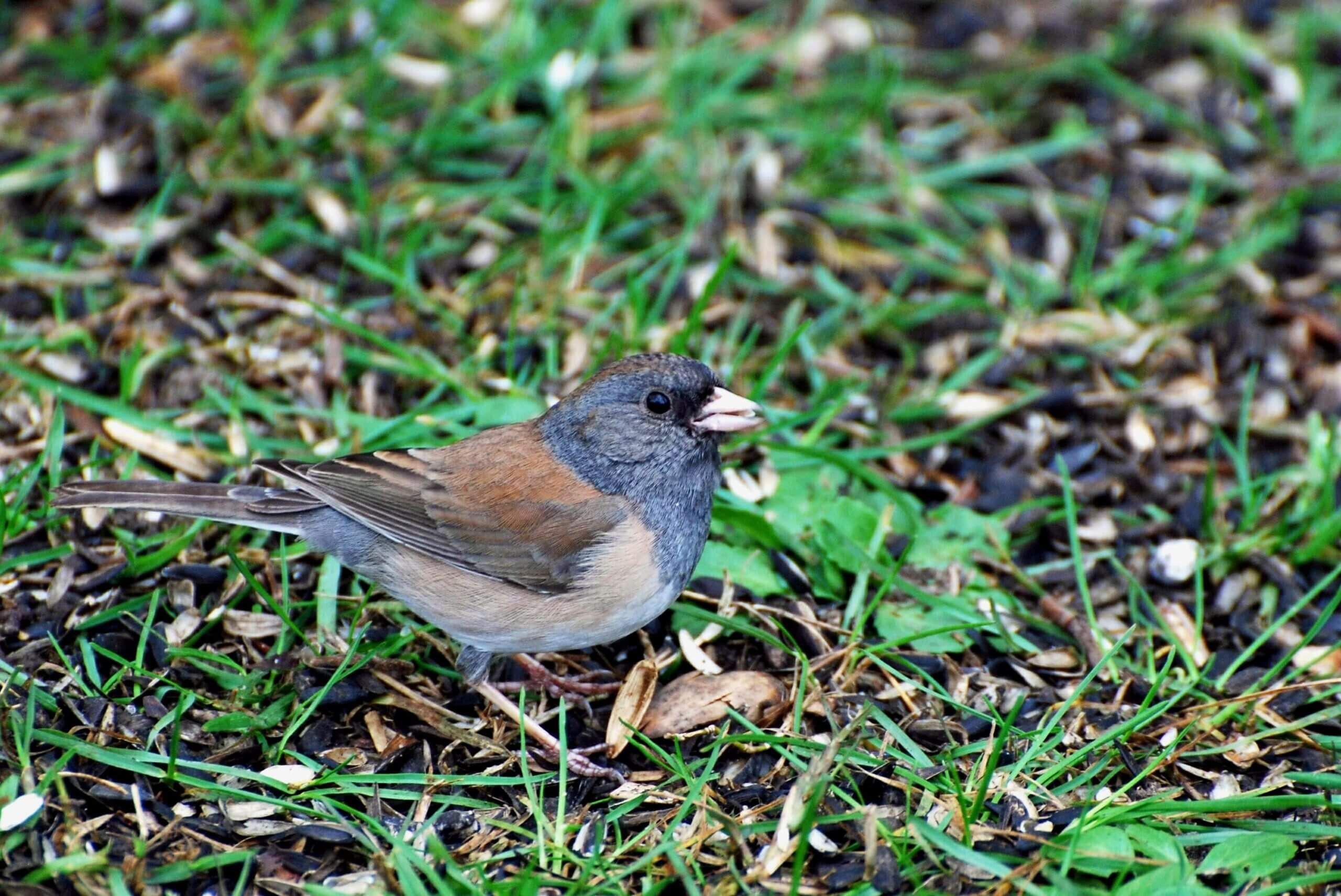
Junco foraging on the ground
February
Brandegee’s Sage is usually the first of the native salvias to bloom; Golden Currants and some gooseberry species are also blooming. Bumblebees, carpenter bees, and hummingbirds are drawn to these plants for nectar and pollen. Bee Flies seem particularly attracted to the Golden Currant flowers; berries follow in about a month. In my Novato garden there are usually very few berries, and they disappear quickly!
A persistent population of Bee Flies is a good indicator that lots of native bees are in the area. These true flies parasitize the larvae of a number of solitary bee species; the females are able to just “shoot” their eggs into the nest chambers where the fly larvae will feed on the larvae of the bees.
The seeds of the salvia are ripe by late spring, and then the finches are busy feeding on them. Finches take the seeds from the plants, but they are messy about it, dropping many seeds while the feed. Sparrows, like the California Towhee, and the Juncos forage for seeds and insects in the duff. A layer of mulch beneath the shrubs helps to sustain insect populations on the ground which are also important for the ground-feeding birds.
Cool season native bunchgrasses, like California Fescue and Tufted Hairgrass are often in bloom. Perennial grasses are important in a habitat garden; they not only provide cover for insects and nesting materials for birds, the seeds that set later in the season are food for all sorts of creatures.
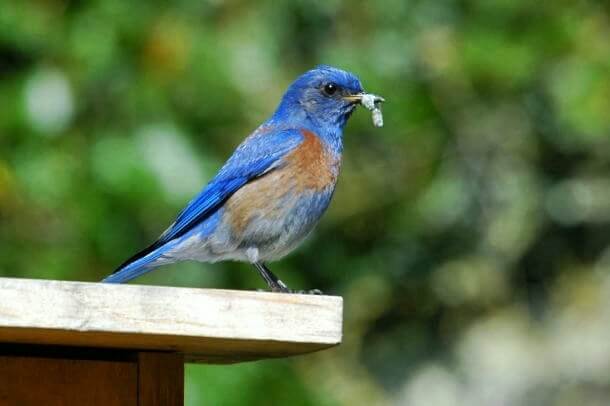
Male Bluebird with caterpillar
March
By this time various Ceanothus start to bloom; the first one in my garden is usually ‘Ray Hartman’. Many other Ceanothus species and cultivars follow, one after another, until about the end of April. The clusters of tiny flowers attract numerous insects, and the birds that feed on them. A number of songbirds, like finches and sparrows, also eat the flowers, as well as the seeds that ripen about a month later.
The fresh new leafy growth of various Ceanothus species hosts the larvae of several lepidopteran species: California Tortoiseshell, Pale Swallowtail, Echo Blue, Hedgerow Hairstreak, the Pacuvius Duskywing, and the Common Sheep Moth, a large and beautiful day-flying moth. Sad to say, especially for the butterfly lover, but all those soft-bodied caterpillars are excellent food for songbird nestlings!
Sometimes towards the end of March, sometimes at the beginning of April, the Barberries and Redbuds burst into bloom. Nevin’s Barberry is covered in small yellow flowers, and the pink flowers of Redbuds cloak still leafless stems. These native shrubs, planted in proximity to a Ceanothus, create a spectacular show of glorious colors! All sorts of bumblebees, honeybees, native bees, hover flies, and butterflies are attracted, and provide food for birds. Hummingbirds also forage among the masses of flowers.
Nevin’s Barberry’s soft red berries ripen by early June; in my garden the fruit set is prolific. All sorts of birds come for these fruits, which can persist on the plant for six months or more. Even the deer eat the berries, carefully nibbling at them in between the very spiky leaves.
California’s flora is particularly rich in berry-producing shrubs; many will be blooming in spring and ripen fruits towards the end of summer or early fall. Osoberry and Snowberry grow nicely in the woodlands as understory shrubs, and beneath the shrubs, a spreading cover of wild strawberries will also provide fruits that sustain bird life. In riparian habitats even more berry producing shrubs grow and provide sustenance: Twinberry, Blackberry, Thimbleberry and Salmonberry.
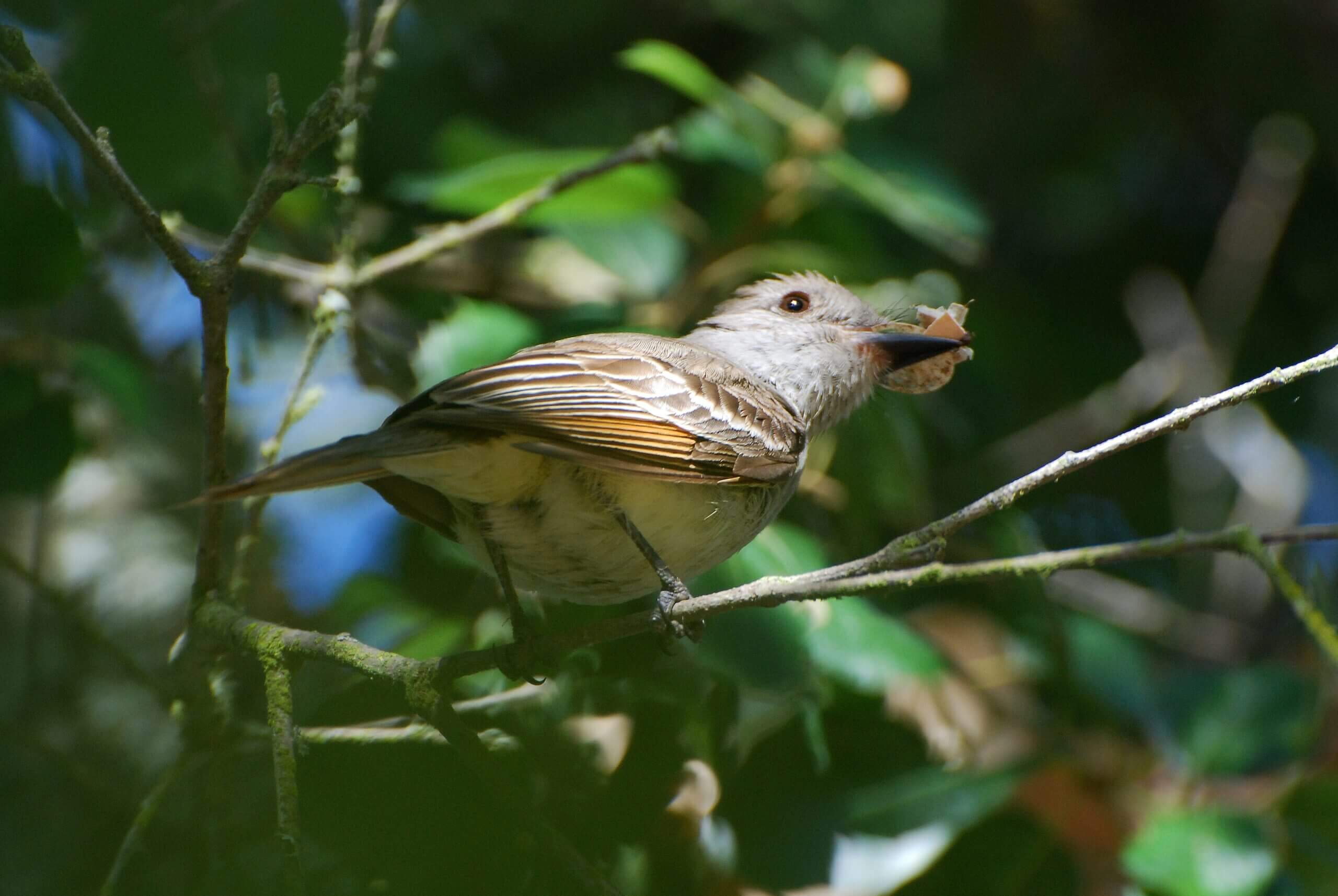
Ash-throated Flycatcher with a California Ringlet – food for its nestlings!
April
By this time of year many native annual wildflowers are in full bloom. The seeds may have germinated with the very first rains, sometimes in early October, but don’t really put on much growth, or bloom, until the days lengthen. Many of the best wildflowers for pollinators are either composits, or have flower heads packed with many small individual flowers, such as the gilias and phacelias. Fern-leaf phacelia is noted the world around as the very best forage plant for honeybees. All the native solitary bees, butterflies, and hover flies take advantage of these rich sources of nectar and pollen.
Clarkias (and there are many different species) tend bloom in succession. Some quaint common names refer to this; the first species to bloom are sometimes called ‘Farewell to Spring’, the next to bloom are ‘Herald of Summer’. One species of native leafcutter bees is commonly called the clarkia bee because of its affinity with these wildflowers. I’ve seen neat little circles cut from the flower petals, and found the correspondingly colored brood cells of this bee.
Seaside daisies are also blooming by April, as is yet another native salvia species, Purple Sage. The insects attracted to these plants include lots of pollinators, as well as plant-feeders, and the predatory insects that feed on them. Mid-season grasses, like Purple Needlegrass, our “state grass”, is in bloom and when seeds have set there is plenty for all creatures. The needlegrass is also a host plant for the little California Ringlet butterfly which is often abundant in the open meadows all summer.
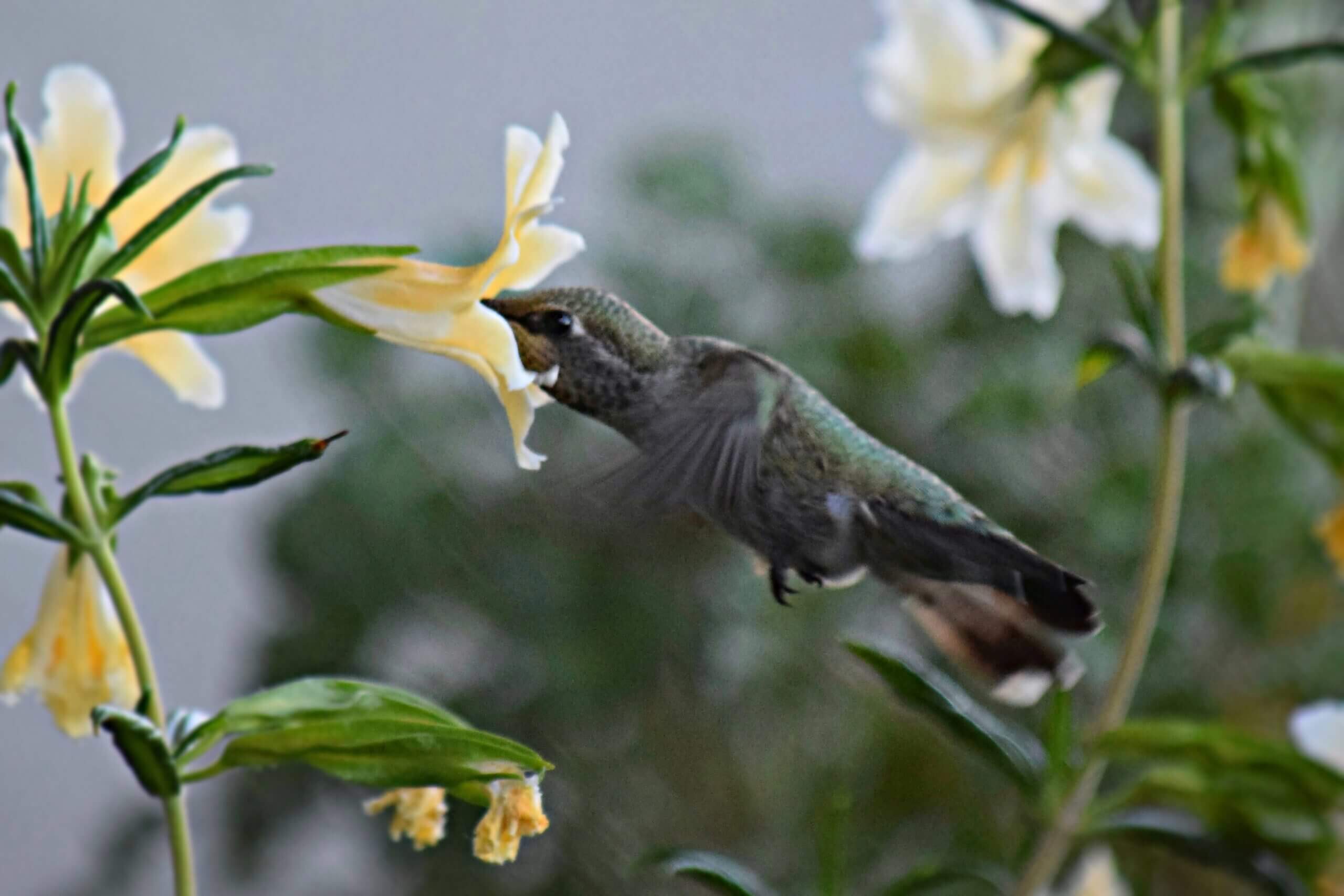
Anna’s hummer foraging at Sticky Monkeyflower
May
Usually in mid-May, the showy milkweed puts on a spectacularly beautiful and fragrant display, with huge flowering heads that attract numerous insects. Many are pollinators, others live on the plants, and others arrive to predate on these populations of insects. Milkweeds are host to a specific seed bug, a long-horned beetle, as well as larvae of a milkweed moth, and the Monarch butterfly and. One of the more interesting insects that I always see hunting at a patch of milkweeds are the “spider hawks”. They are large carnivorous wasps which hunt for spiders in particular, to serve as living hosts for the larvae of the spider hawks!
Milkweeds also produce ample seed, and each seed has a silky “parachute” attached; this is wonderful nesting materials for the birds that breed a little later in the season.
Salvias and the Sticky Monkeyflowers bloom all through this month. Hummingbirds trapline drifts of these shrubs, and when I’m lucky, I’ll even spot an Allen’s or Rufous hummingbird “fueling up” to continue on their migration north to breeding sites. Seeds set later in summer provide for birds and the small insects which many birds also eat.
Also blooming in May are the first of the Buckwheats, Checkerbloom, flowering native bulbs, like blue dicks and tulip lilies, and still more wildflowers. Checkerbloom flowers offer lots of pollen for foraging bees, as many mallow family plants do; and it’s also a host plant for the larvae of the Common Checkered Skipper, Purplish Coppers, and the West Coast Lady butterflies. Buckwheat plants also host the larvae of several species of the tiny, and delicately beautiful “Gossamer-winged” butterflies.
There are numerous native Buckwheats; various species that bloom from early spring into late summer. The flowers attract all sorts of pollinators, and seed set can be prolific; even better – the seed heads persist on the plant right through the winter months, providing food for resident and migrant species alike.
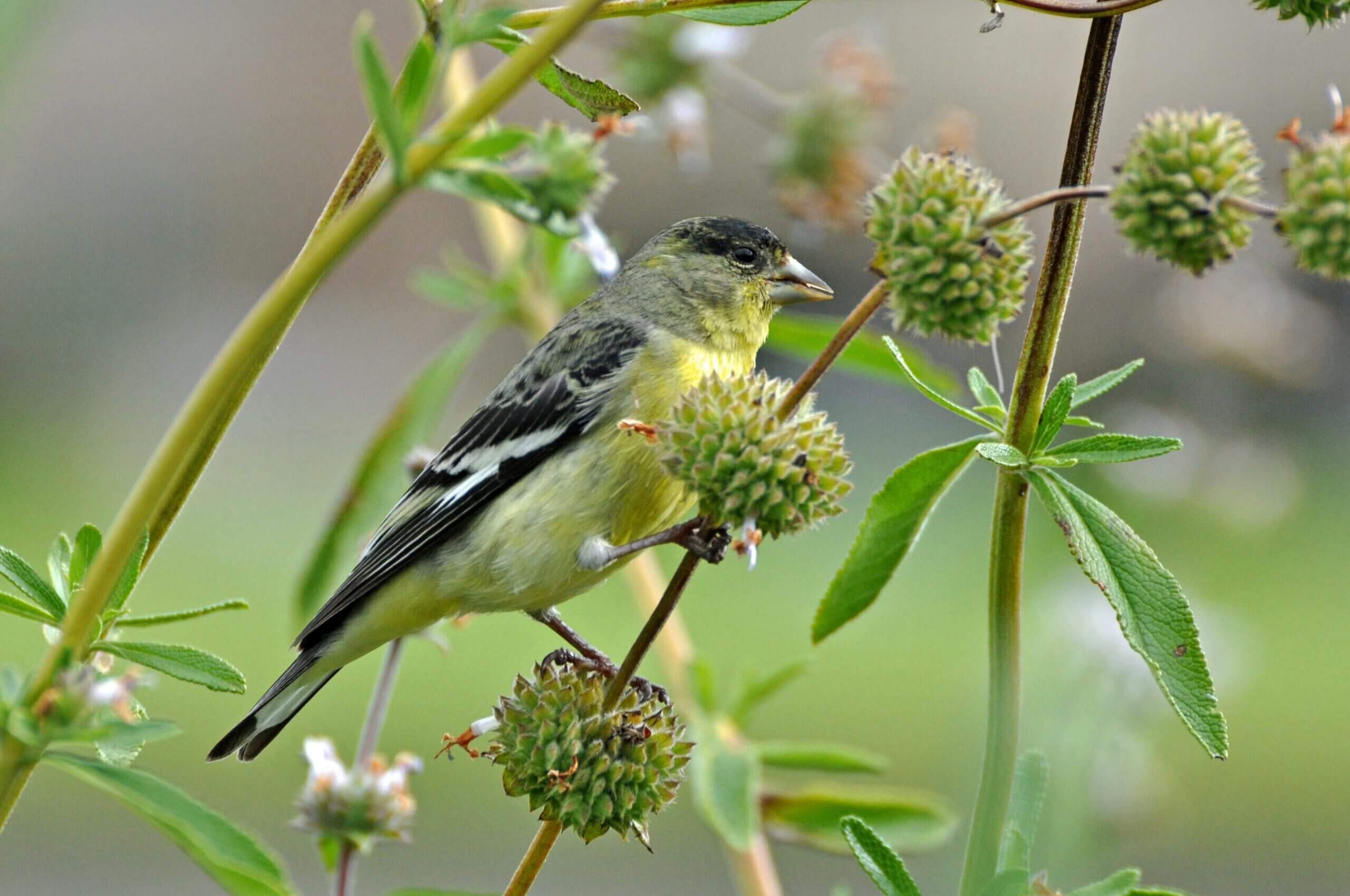
Goldfinch on Black Sage
June
More native salvias like Cleveland’s sage, black sage, and white sage are in full bloom, but this is usually the end of the really show-stopping floral displays in my native garden. All the hummers in the neighborhood, at least all the females allowed into a territory fiercely defended by one dominant male, are taking full advantage of all the flowers have to offer.
Even the tiny, barely open, flowers of the California Bee plant attract the hummers, as well as native bees and other insects.
In the woodlands Coffeeberry and Elderberry are often in bloom about this time; their clusters of small flowers attract lots of pollinating insects. Coffeeberry is also a host plant for the larvae of the Pale Swallowtail. Berries set and ripen by the fall, and since they persist on the plants, they provide for resident and migratory birds and other creatures.
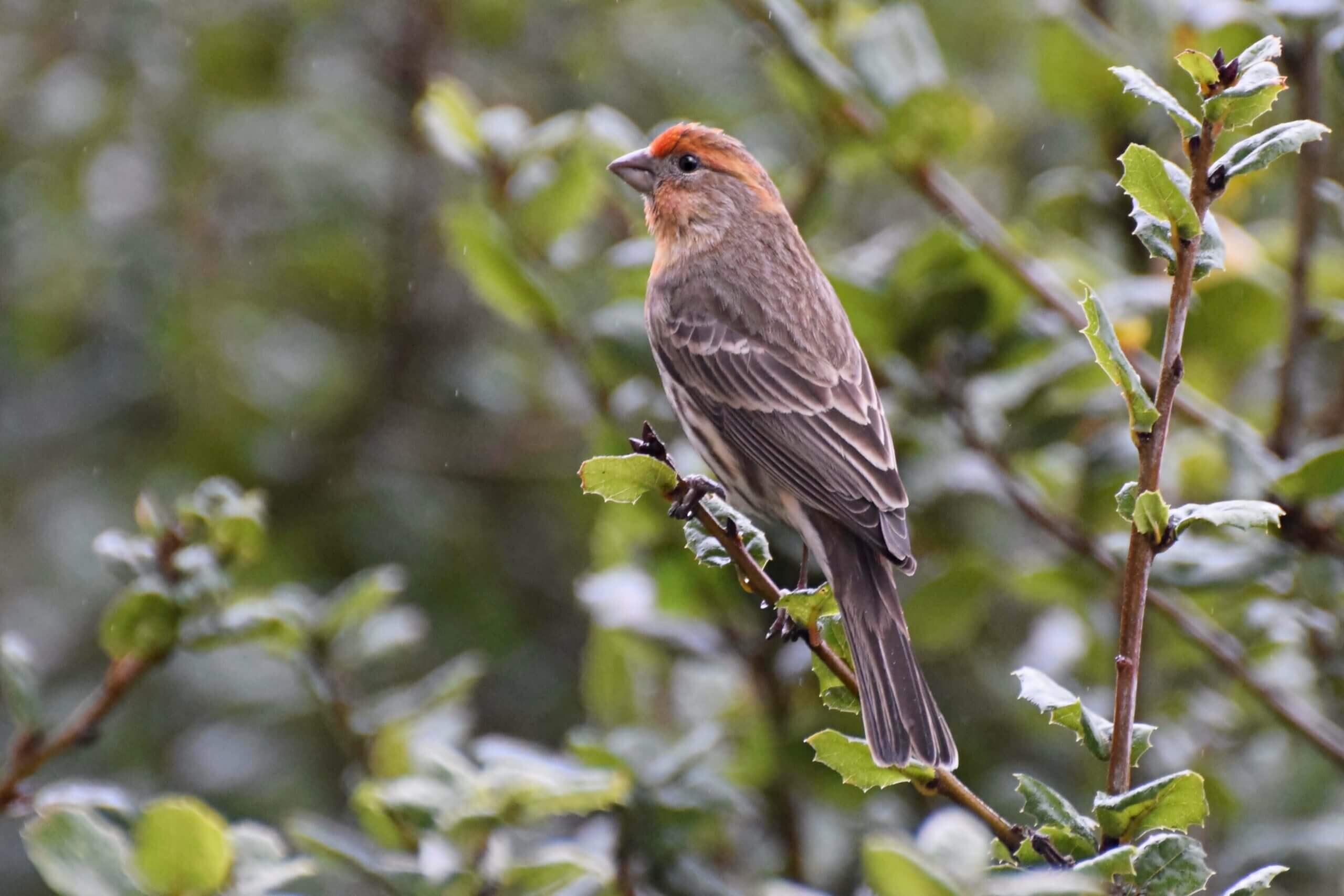
A young male House Finch
July
Toyon starts to bloom sometime in June or July, attracting lots of pollinators; berries will be set by fall, but ripen slowly and persist until December or even January, providing resources easily seen by large flocks of migrating songbirds.
Island Bush Snapdragon’s bright red flowers attract the hummingbirds; and brighten up the light shade under the oaks. Soap Lilies might also start their bloom cycle now; the white flowers open in the late afternoon, attracting lots of bumblebees as well as nighttime pollinators like moths.
Berries are formed and ripening on Snowberries in the woodlands, and in riparian zones, Creek Dogwood and Twinberries are blooming; the subsequent berries are relished by birds and other creatures.
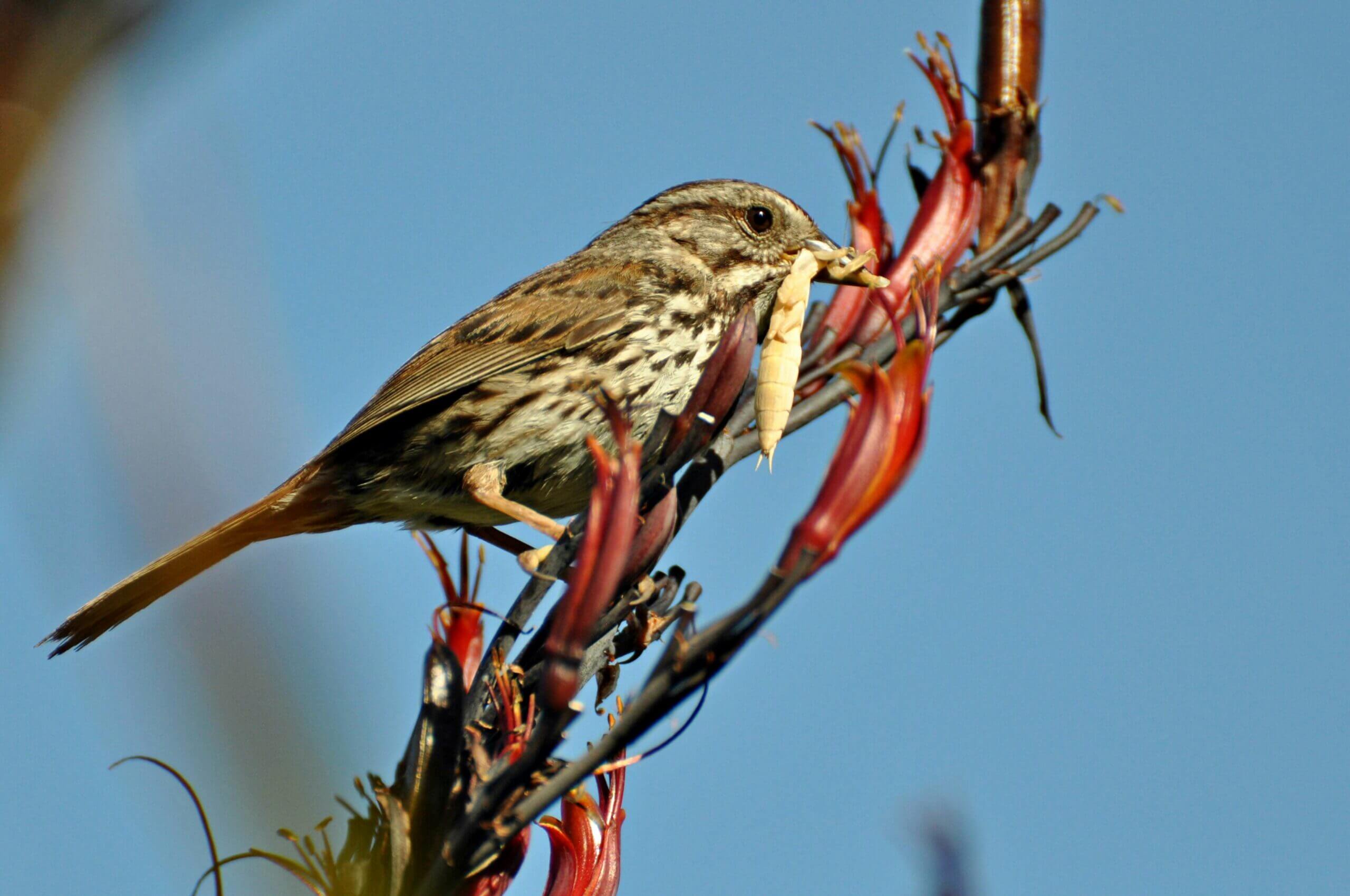
Sparrow with a very large insect!
August
This is when the Tarweeds are at their best. I grow three species, all of which have naturalized and established colonies all over my property. The fragrant flowers are abundant throughout the summer and well into fall; they are especially attractive to native longhorned bees. Later, when seed has set, I’ve noticed flocks of Goldfinches foraging through the drifts of Tarweeds.
More buckwheats are in bloom; the shrubby, narrow-leaf Buckwheat, and the giant St. Catherine’s Lace. Once seeds have set, the flowering heads become an attractive rusty color and persist on the plant through the fall and winter months.
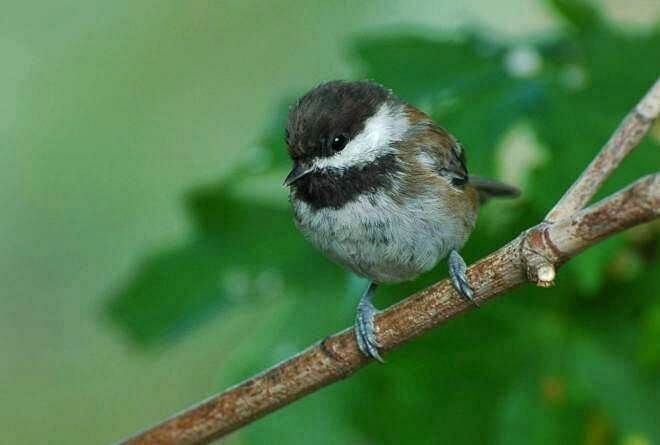
Chestnut-backed Chickadee
September
California Fuchsias, Goldenrods, Asters and Gumplants are blooming, creating another glorious show in mingling shades of red, yellow, and purple flowers! The reddish flowering fuchsias are hummingbird magnets, especially important for Allen’s and the Rufous hummingbirds migrating back to warmer over-wintering sites.
Goldenrods, but most especially Asters (of all species, even non-natives), are excellent insect attractors; every bee and butterfly in the neighborhood is foraging at these flowers. While foraging, these insects are also pollinating, and both the resulting seeds, and the chaff that forms around the seeds, are valuable resources for birds.
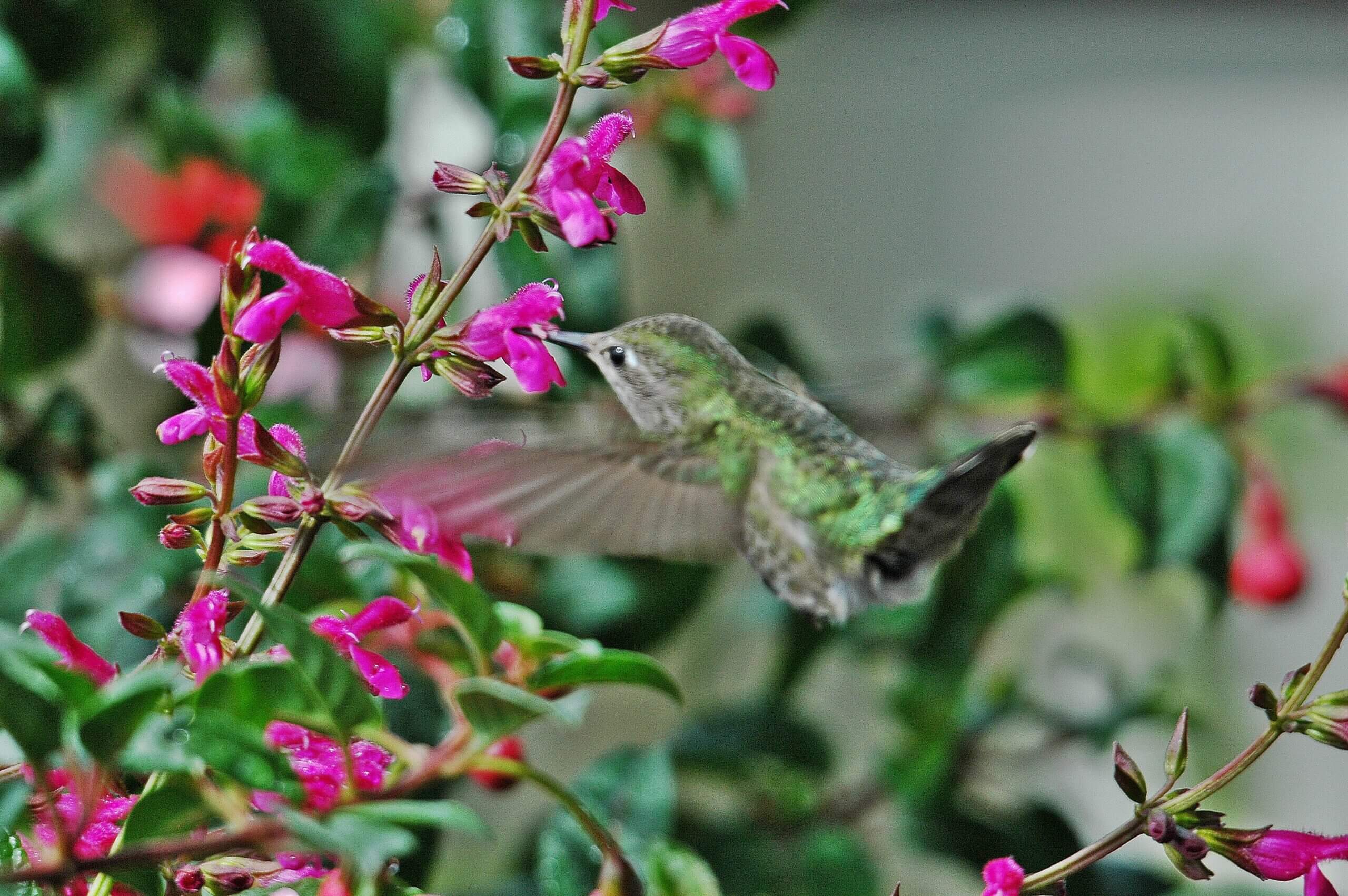
Anna’s hummingbird feeding at Chiapas Sage
October
Coyote Brush is an important source of both pollen and nectar in the fall garden. Studies have shown up to four hundred species of insects associate with Coyote Brush; so it’s a very valuable resource for all sorts of bird life.
Wax Myrtle berries have set, and lots of birds are drawn to these.
Berries of many native shrubs persist in good shape on the plants; there may well be remnants of Elderberries, currants, and even native grapes.
During these months, flowers for hummingbirds are sparse, so thinking as a habitat gardener first and foremost, I have numerous non-native Salvias throughout my garden. Many South American species are in full bloom from October to January, and Anna’s hummingbirds definitely appreciate them! I have not found any of these non-native salvias behaving as potentially invasive species.
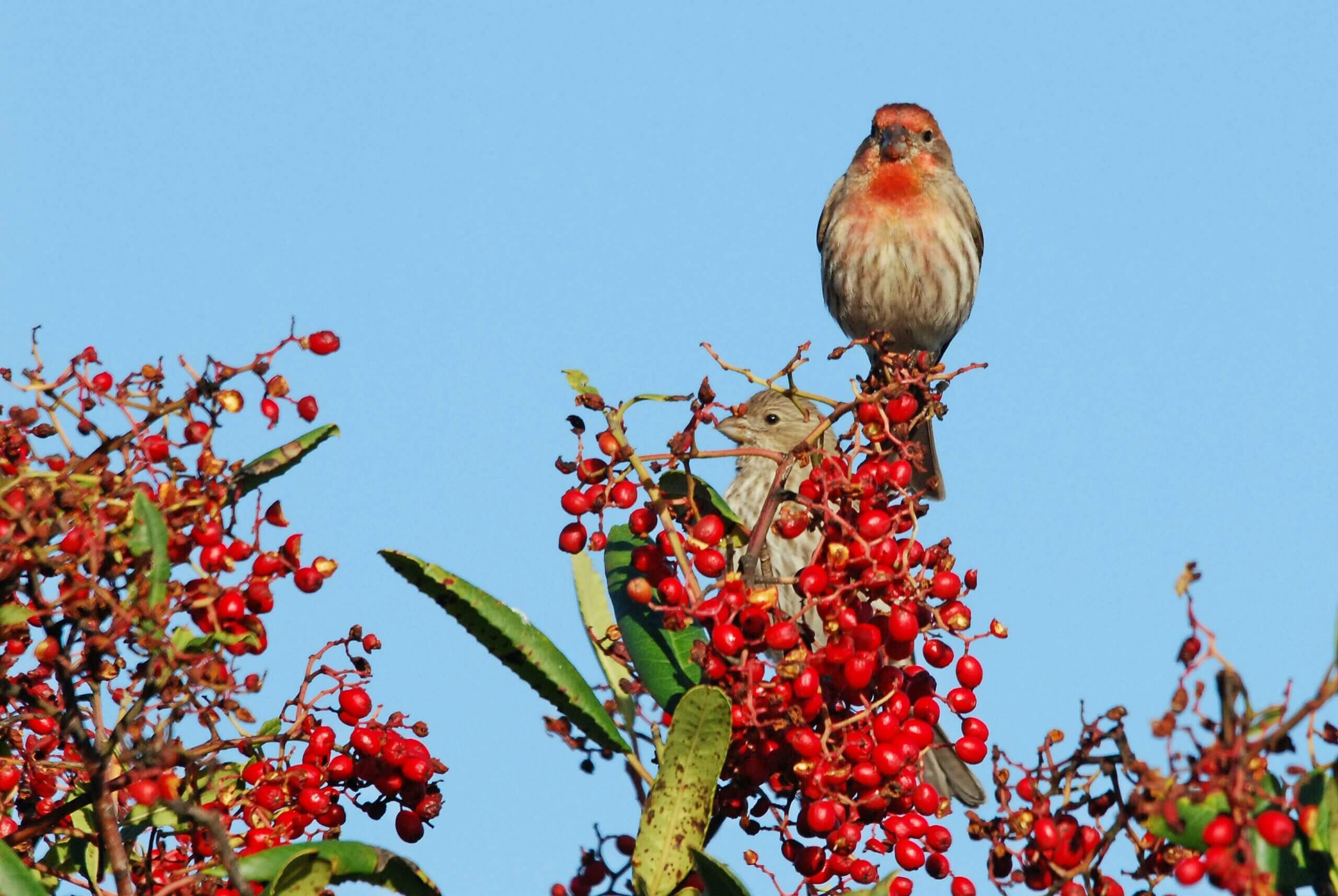
House Finches on Toyon
November to December
Toyon berries are red and fully ripened; flocks of both resident and migratory birds gorge on them before moving on. Warm season bunchgrasses, like Deer Grass, Idaho fescue, and Blue Grama and have set seeds, and on some of the late blooming plants, like asters and goldenrods, seeds are sometimes still an available food source.
This is the time of year when the seeds and mast of established, mature trees become the most valuable food source for birds and a host of native creatures.
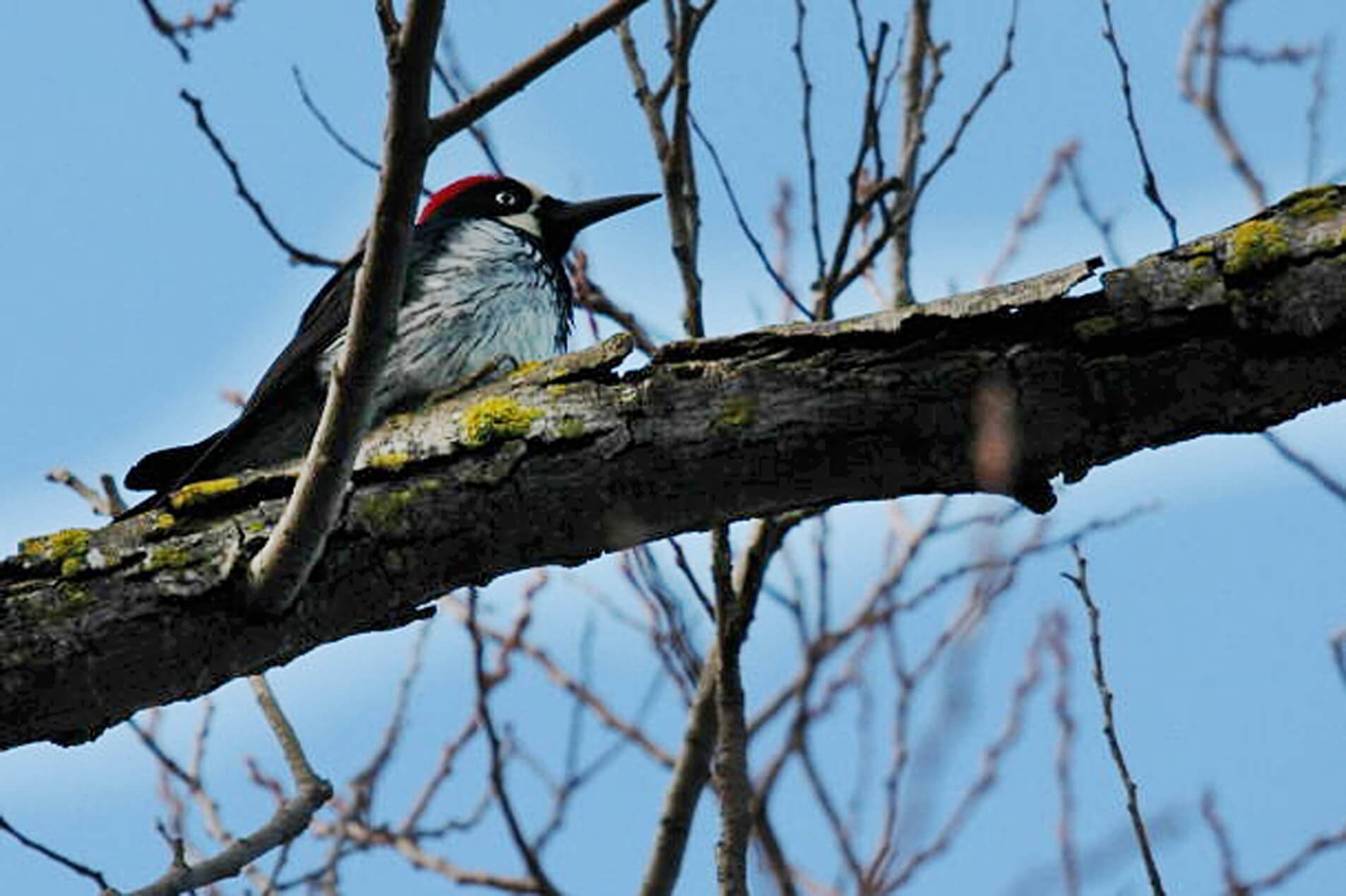
Acorn Woodpecker
California’s native oaks are especially important habitat; studies show that oak trees provide resources for about 5,000 life forms; from a host of invertebrates to amphibians and reptiles, to birds , rodents, and other mammals, including human beings! The larvae of several species of butterflies, including the California Sister, feed on this tender new growth. In mid summer oak trees will sometimes exhibit signs of the ‘drippy nut’ condition. A very sticky, resinous substance forms around the developing acorns, and drips down onto surfaces below. I see lots of birds, including hummingbirds, carefully foraging around these sticky clusters of developing acorns; they may well be picking up insects that have been trapped in the sticky substances. In the fall, when the acorns are mature they are a rich source of protein, fat, and carbohydrates for numerous creatures. Many birds, including the acorn woodpeckers and scrub jays, prefer to pick their acorns from the tree, not off the ground.
California Bay blooms in early spring, and the clusters of flowers attract pollinating insects. The fruits that are produced by late summer contain a large nut within the fleshy fruit; these are favored by squirrels. It’s interesting to see how they open the fruit at one end to extract just the nut, leaving behind an open case with a little “lid” still attached!
Madrone flowers are loved by the hummingbirds, and many birds and other creatures eat the red berries that follow. I’ve seen large flocks of band-tailed pigeons move from one stand of madrone trees to the next, taking full advantage of the bounty. Th e berries that fall to the ground are food for small rodents and ground-feeding birds, like sparrows, thrushes, and turkeys.
The California Buckeye tree produces flowers with lots of nectar and pollen; it is a common belief that these flowers are toxic to bees. The nectar and pollen are toxic to the introduced honeybee, but for all the many species of solitary native bees they are a rich resource! The new leafy growth also supports the larvae of several species of the tiny “gossamer-winged” butterflies. In the fall the large nuts that develop, though toxic in many respects, is an important source of food for both ground squirrels and western gray squirrels; these creatures are able to handle the toxicity of the buckeye nuts!
Big leaf maples, alders, and willows are most often growing in riparian zones, where the cover and cooling effect on the water below is critically important for a well balanced riparian ecosystem. These trees also host a number of insect species in the immature stages, including the larvae of one of the largest and most spectacular of butterflies, the Western Tiger Swallowtail. Seeds are often produced in large volumes that spread on the winds or float on the water, providing food for all sorts of creatures.
Conifers, including the Coast Redwoods, provide cover and nesting sites for birds. There is not much insect life directly associated with these trees, but they usually grow in moist forest conditions, and many different life forms that are food for birds can be found in duff that forms on the forest floor.
California’s native cherries, both the Holly-leaf and the Catalina Cherry set fruits that are sweet and edible. The flowers bloom in early summer, attracting lots of pollinators; fruits follow in late summer. They don’t last long; along with the birds, deer and rodents also eat the fruits.
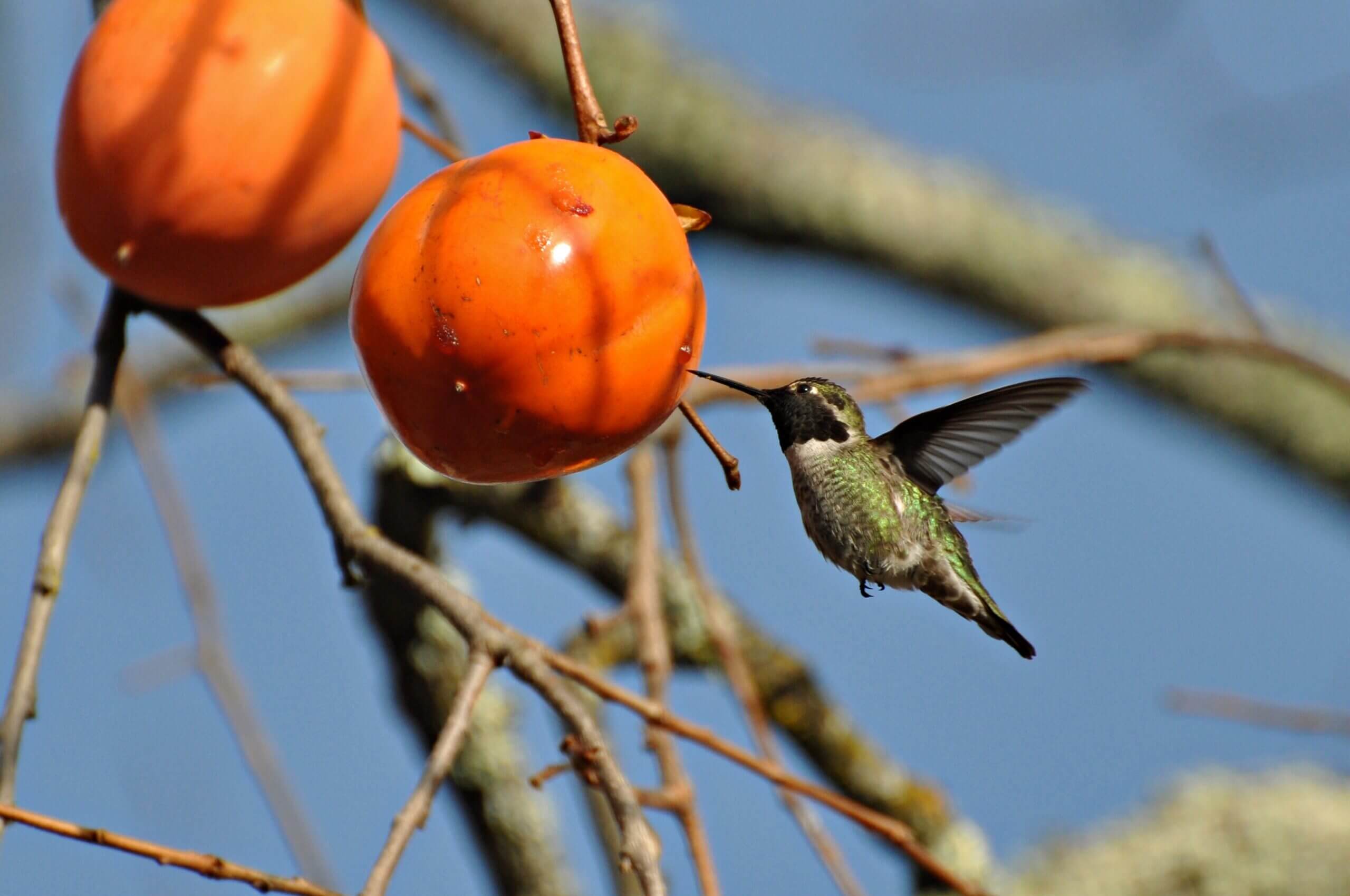
Anna’s hummingbird feeding on a Persimmon
Fruit trees are always a valuable addition to a habitat garden, as are vegetables. Most animals, including many birds really like human foods. Some birds, such as Tanagers and Orioles, rely heavily on soft fruits, and other birds like the sparrows want their spring greens!
The difficulty for the gardener, whose hard work and tending to these trees makes them a rich resource, is that these creatures don’t always realize that they should take only a share of the bounty!

